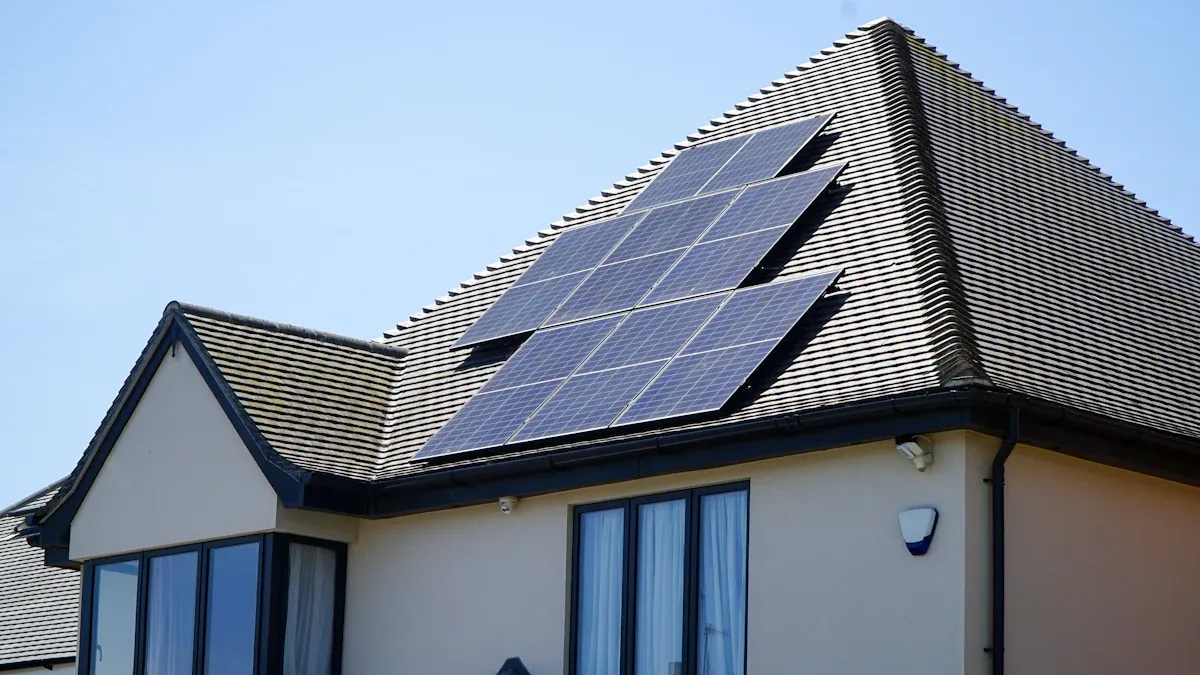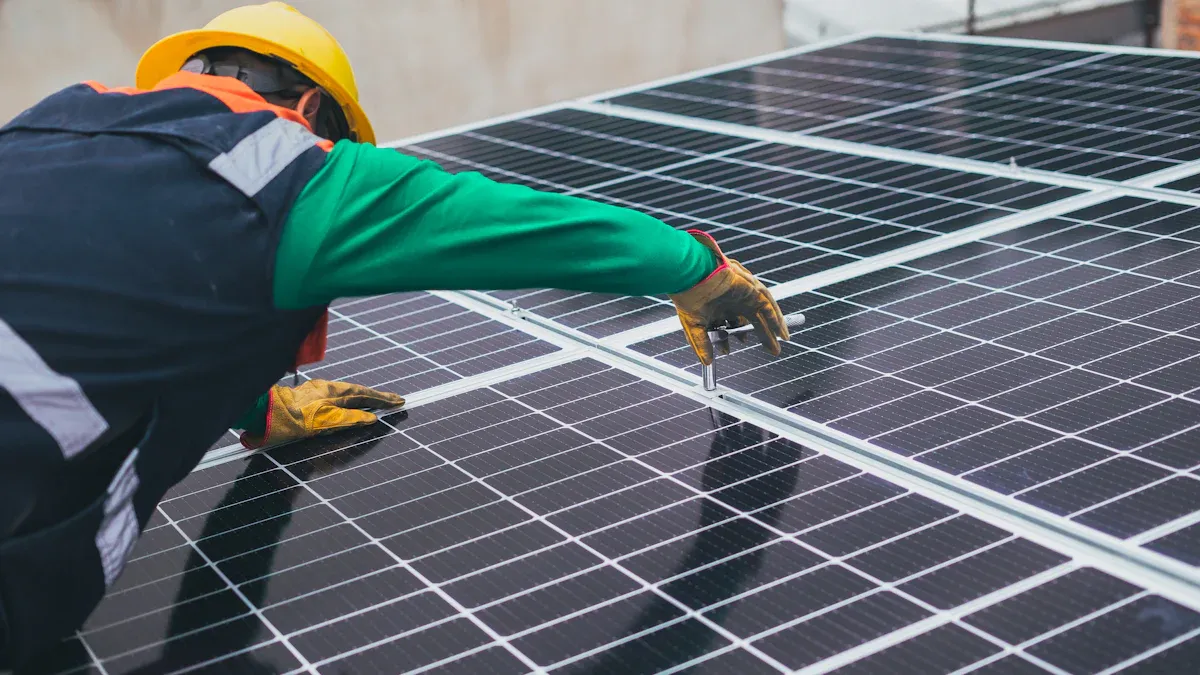- All
- Product Name
- Product Keyword
- Product Model
- Product Summary
- Product Description
- Multi Field Search


Views: 228 Author: Site Editor Publish Time: 2025-10-21 Origin: Site

Most homes need between 15 and 25 solar panels to cover all their electricity needs. Your exact number depends on how much energy you use, how much sunlight your home gets, and how much roof space you have. The average U.S. household uses about 10,791 kWh of electricity each year. If you live in a sunny area, you might need fewer panels than someone in a cloudier place. Roof size matters, too. For example, 20 panels may require about 353 square feet of roof space.
Most homes need 15 to 25 solar panels. This number depends on how much energy you use. It also depends on sunlight and roof size.
Add up your monthly kWh from bills for a year. This shows how much electricity you use in a year. It helps you know how many panels you need.
Think about how much sunlight your home gets. More sunlight means you need fewer panels for the same energy.
Pick modern solar panels between 350 and 460 watts. These panels work better. The watt number changes how many panels you need.
Always round up the number of panels you need. This gives you enough power on cloudy days or if you use more energy.

You probably wonder how many solar panels you need for your home. Most homes in the United States use about 10,566 to 10,791 kilowatt-hours (kWh) of electricity each year. This means the average home uses about 29 kWh per day. Your electricity use depends on your home’s size, the number of people living there, and your daily habits.
If you live in a smaller home, you will likely use less electricity. For example, a home under 1,000 square feet uses about 490 kWh per month. A larger home, over 2,500 square feet, can use more than 1,470 kWh per month. The number of people in your home also matters. A single person uses about 630 kWh per month, while a family of five or more can use over 1,000 kWh per month.
The amount of sunlight your home receives changes how many solar panels you need. Homes in the Southwest, like Phoenix, get about 5.75 hours of peak sunlight each day. Northern cities, such as Seattle, get fewer than 4 hours. If you live in a sunny area, you need fewer panels to make the same amount of electricity.
The type of solar panels you choose also affects the total number. Most new residential panels produce between 350 and 460 watts each. Some older panels make less, between 250 and 300 watts. In places like Nevada, many homeowners use panels rated between 390 and 460 watts, with 450-watt panels being very popular.
Tip: The more sunlight your home gets, the fewer solar panels you need to meet your energy needs.
You can use the tables below to estimate how many solar panels you might need based on your home size and location. These numbers assume you want to cover 100% of your electricity use.
Home Size (sq ft) | Estimated Annual Power Needs (kWh) | Number of Solar Panels Needed* |
|---|---|---|
1,000 | 3,600 to 4,800 | 10 to 12 |
1,500 | — | 15 to 18 |
2,500 | 11,500 to 13,000 | 25 to 28 |
Square Footage | Average kWh/month |
|---|---|
Under 1,000 sq ft | ~490 |
1,000-1,499 sq ft | ~735 |
1,500-1,999 sq ft | ~980 |
2,000-2,499 sq ft | ~1,225 |
2,500-2,999 sq ft | ~1,470 |
3,000+ sq ft | 1,470+ |
Number of People | Average kWh/month |
|---|---|
1 person | ~630 |
2 people | ~775 |
3 people | ~870 |
4 people | ~950 |
5+ people | 1,000+ |
If you live in Hawaii, you might use about 18 kWh per day. In Louisiana, the average is closer to 40 kWh per day. These differences show why it is important to consider your location when planning your solar panel system.
Note: The number of solar panels you need depends on your home’s size, your energy use, the amount of sunlight you get, and the wattage of the panels you choose.
You can figure out how many solar panels you need by following a few simple steps. This process helps you match your energy use with the right system size for your home.
Find your yearly electricity use.
Look at your electric bills to see how many kilowatt-hours (kWh) you use in a year. Most bills show your monthly use, so add up twelve months to get your total.
Estimate your sunlight hours.
Check how many hours of full sun your home gets each day. You can use online maps or ask a local installer. Most homes in the U.S. get between 4 and 6 hours of sunlight per day.
Choose your panel wattage.
Decide which solar panels you want. Most modern panels produce between 350 and 460 watts each.
Use the formula:
Divide your yearly electricity use by the product of daily sunlight hours, 365 days, and panel wattage.
Formula:
Number of panels = Yearly kWh ÷ (Sunlight hours × 365 × Panel wattage ÷ 1,000)
How much energy you use changes how many solar panels you need. Every home uses electricity in its own way. If your family is big, you probably use more power. You need electricity for lights, appliances, and electronics. Heating and cooling systems can make you use even more energy. This is true if your summers are very hot or your winters are very cold. Water heaters, using kitchen appliances a lot, and charging electric vehicles also add to your total electricity use.
Bigger families usually use more energy.
Air conditioning and heating use lots of electricity.
Washers, dryers, and dishwashers need extra power.
Electric water heaters use a lot of energy.
Indoor and outdoor lights add to your usage.
Charging an electric vehicle at home uses more electricity.
How much sunlight your home gets changes how much energy your solar panels make. If you live somewhere sunny, your panels make more electricity each day. If you get less sunlight, you might need more panels to get enough power. For example, California gets about 5.5 to 6 hours of strong sun every day. The United Kingdom only gets 2 to 2.5 hours.
You can look up sunlight data for your area. Try the National Renewable Energy Laboratory (NREL) or the U.S. Energy Information Administration (EIA).
Your roof size decides how many solar panels you can put up. Bigger roofs give you more space for panels. This means you can make more energy. Things like chimneys, skylights, and vents can take up space. These things can block where you put panels. Measure your roof and look for anything that might get in the way.
The size of your roof tells you how many panels fit.
Chimneys, skylights, and vents take up space and may block panels.
Each panel needs about 15 to 18 square feet.
Most homes need between 300 and 600 square feet for all their panels.
To figure out how many panels fit on your roof, divide your roof’s open area by the size of one panel.

You may ask how much solar panels cost for a home. Most people pay between $18,000 and $38,000 after the federal tax credit. The average price is $2 to $3 for each watt. The total cost depends on your system size, where you live, and what equipment you pick.
Prices can change depending on your location.
When you plan to install solar panels, think about a few things. First, check how much energy you use. Make sure your roof is strong and does not have things like trees or chimneys blocking sunlight. Pick an installer who is licensed and insured. Get several quotes to compare prices and services.
Here are some good ideas for picking an installer:
Check their licenses, insurance, and certifications.
Pick an installer who does the work themselves.
Get more than one quote.
Ask about the skills of any subcontractors.
Choose a local installer for better service.
Ask if the installer is local or has a nearby office.
Find out if they have worked in your area before.
Look at their safety records.
SKYLARK gives expert installation and helps you find the best system for your home. You can ask SKYLARK about local rebates and incentives to save money.
Adding battery storage lets you keep energy for nighttime or power outages. If you put in batteries when you install solar panels, you save on labor and permits. Doing both at once makes things easier and avoids extra work.
Common battery types are:
Lithium-Ion Batteries
Lead-Acid Batteries
Flow Batteries
Lithium-ion batteries are small and light. Lead-acid batteries have been used for a long time and work well off-grid. Flow batteries store energy for longer but need more space.
You can get a 30% tax credit for battery systems that are 3 kWh or bigger. This lowers your total cost. SKYLARK can help you pick the right battery and explain how storage works with your solar panels.
You can find out how many solar panels you need by doing a few things. First, check your yearly energy use and see how much roof space you have. Next, figure out how much system capacity you need. Look at your daily energy needs and how many sunlight hours you get. Then, divide your total system size by the wattage of the panels you pick. Use the calculation guide and tables to help you. Online tools like PVWatts Calculator and Google’s Project Sunroof give quick estimates. A local installer can make a plan just for you. They help you avoid mistakes and make sure your system works for your home. Gather your energy bills and look at ways to pay for your system before you start.
Most solar panels last 25 to 30 years. You may see a small drop in power over time. You can expect your panels to keep working well for many years.
Solar panels alone do not work during a blackout. You need a battery system to store energy. With batteries, you can use your solar power when the grid goes down.
Yes, solar panels still make electricity on cloudy days. They make less power than on sunny days. You will still get some energy even when the sky is gray.
You do not need to do much to keep your panels working. Clean them a few times a year. Check for dirt, leaves, or snow. Most systems need little care.
Many homes with solar panels sell for more money. Buyers like lower energy bills. Solar panels can make your home more attractive to future buyers.